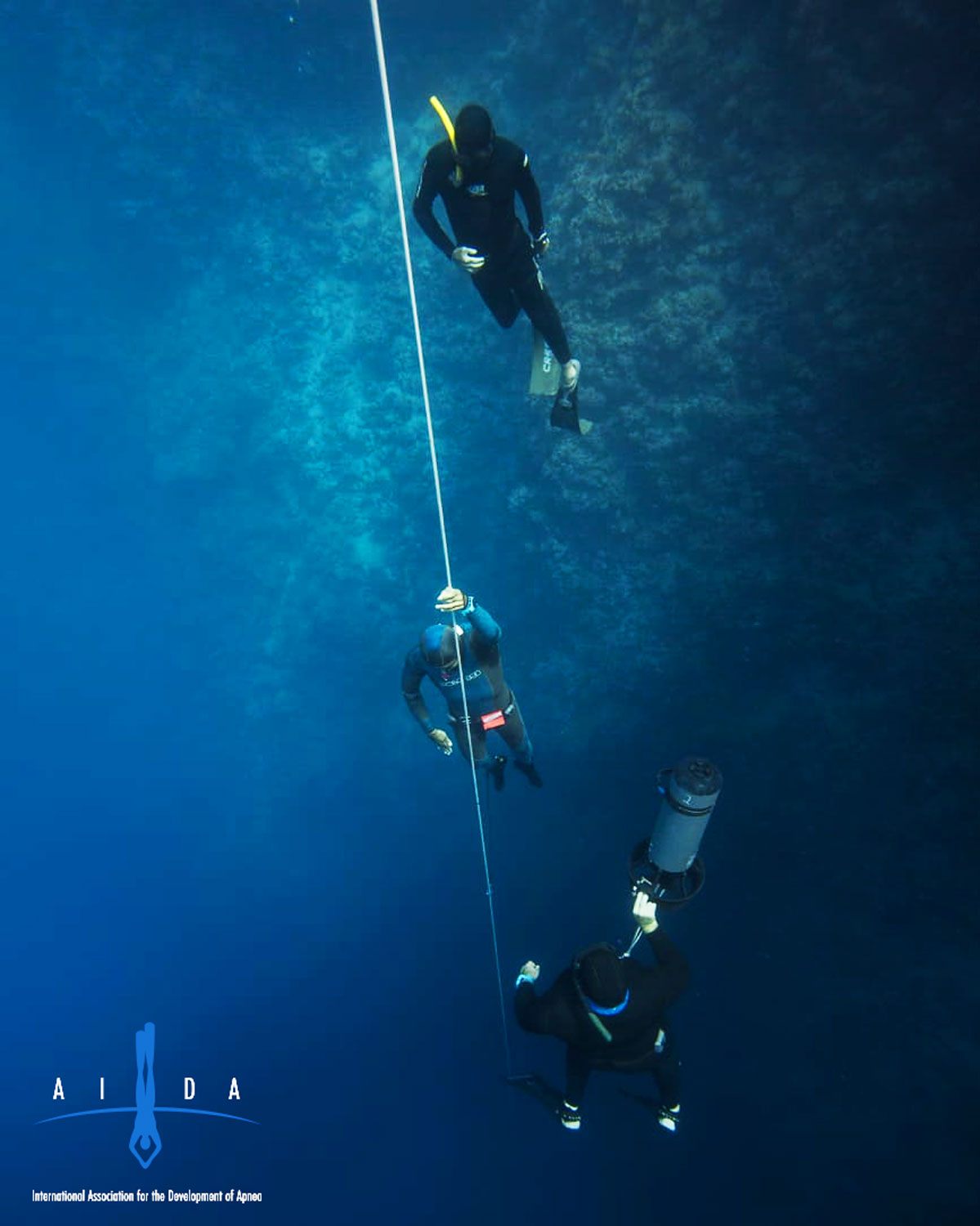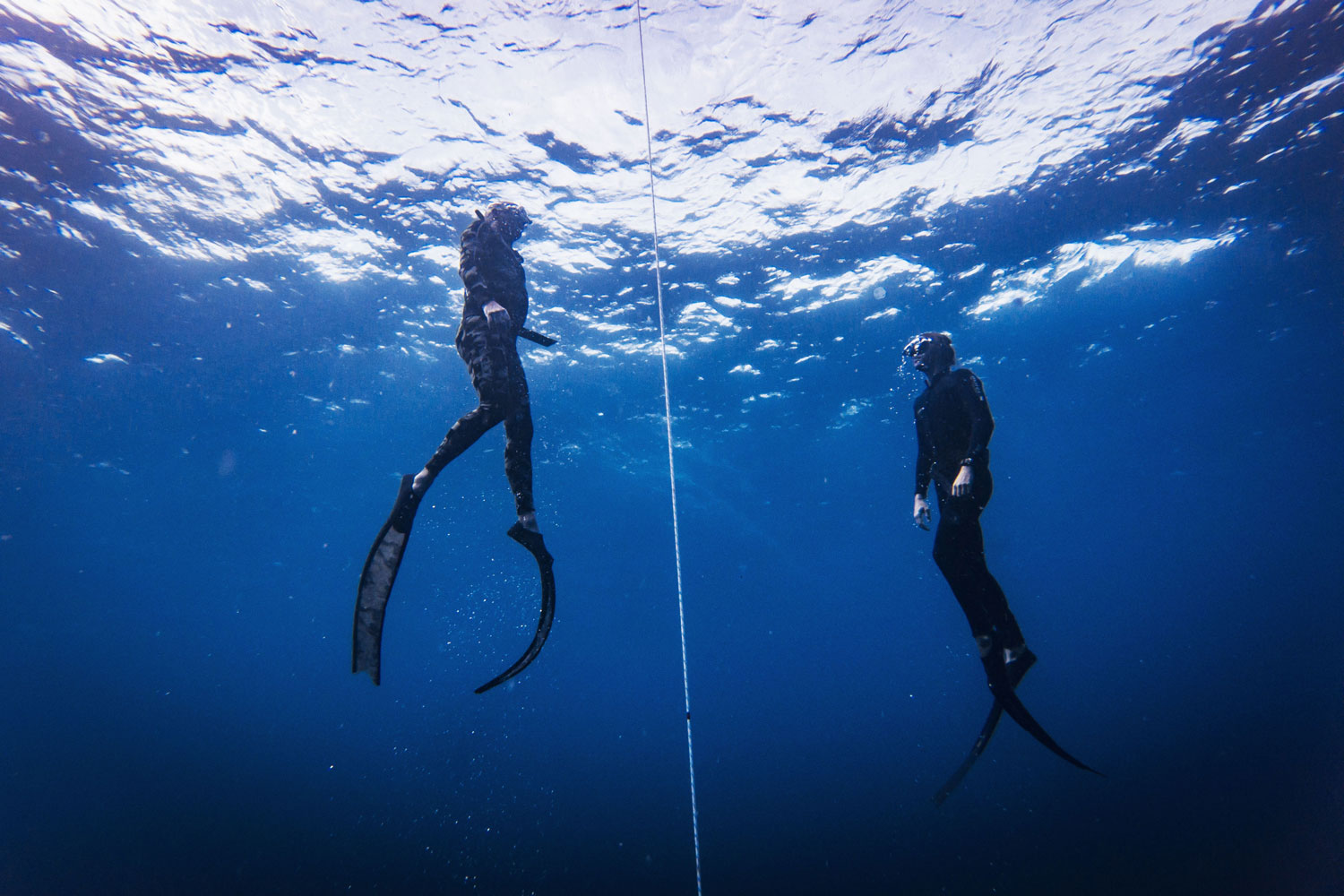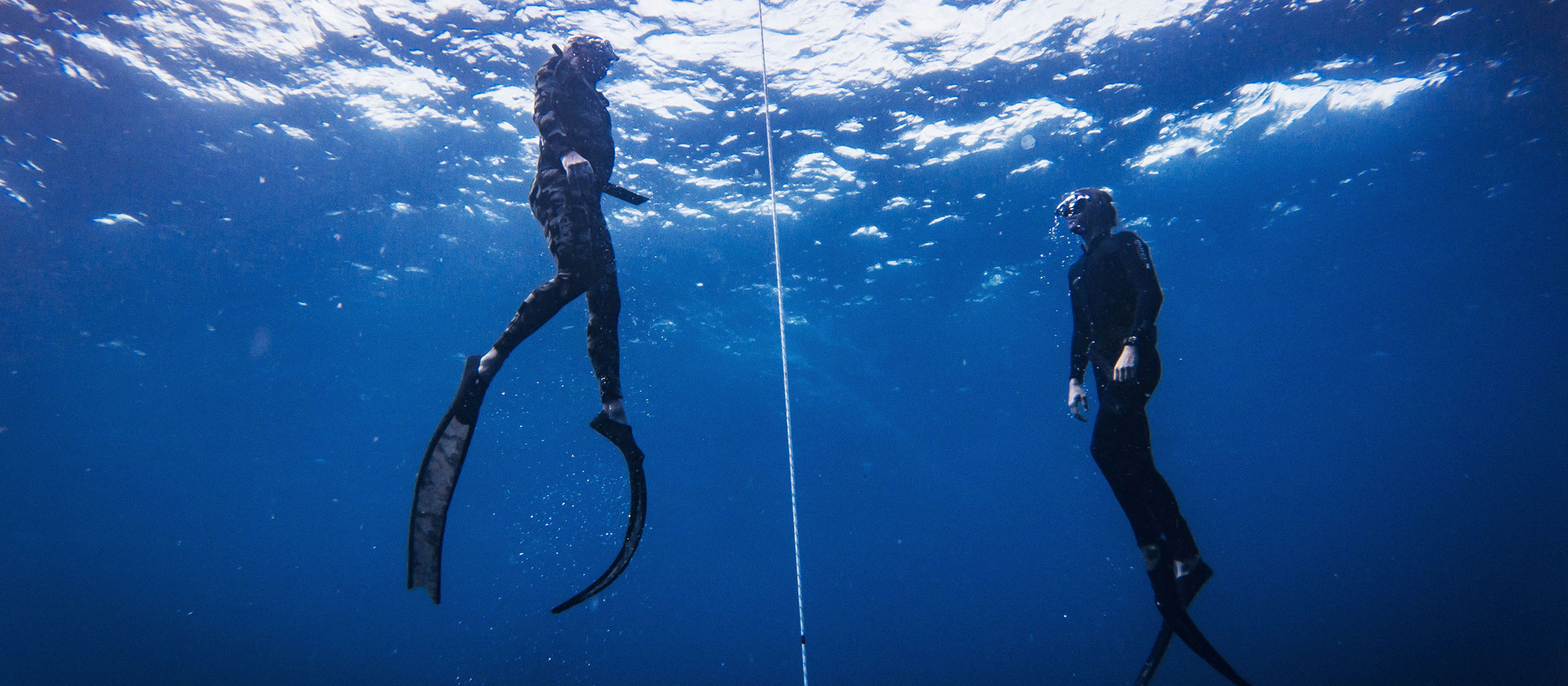Dive stories
Ensuring Safety in Freediving Competitions
In 2002, French freediver Audrey Mestre tried to break the No Limits world record of Tanya Streeter’s, a British-Caymanian-American world champion. When Mestre reached the bottom, the lift bag, which should have transported her back to the surface would not inflate. It appears that the gas cylinder wasn’t appropriately checked before the performance—an oversight that was the subject of speculation but was never shown to be more than horrific human error. This mistake cost the diver her life. It was the first, but unfortunately not the last real death in the sport.
In November 2013, in the Bahamas, US athlete Nick Mevoli took part in a freediving competition after suffering a lung squeeze on an attempt to beat the American record in Free Immersion. On a dive two days later, Nick lost consciousness shortly after returning to the surface. The doctors were unable to revive him.
It was the last lethal incident that occurred during freediving competitions.
Besides being a perfect way to relax during the weekend, freediving is also an international competitive sport. Professional freedivers exploit human diving adaptations to dive to depths of over 200m on a single breath. Since 1992, the Association Internationale pour le Développement de l'Apnée (AIDA), a worldwide federation for breath-hold diving) has been organising freediving competitions around the world, making the sport safer while at the same time ensuring that it remains competitive as ever. Maintaining safety during freediving competitions is one of the primary responsibilities of the organisers of the events and can be achieved only through coordinated efforts of well-prepared medical and safety teams. The Medical and Science Committee and the Safety Committee of AIDA develop and annually review the rules and practical recommendations for organisers, event medics, and safety teams.
Currently, the incidence of adverse events in depth competitions (in most cases, mild blackout and mild respiratory barotrauma) varies between 3 and 4%, which means that three to four out of 100 dives result in freediving incidents. Though this incident rate would be considered high for general diving, it is relatively low and expected during competitions where athletes routinely push their breath-hold limits. The relatively small proportion of incidents, along with very rare cases of severe trauma, and only two lethal episodes are the result of a well-established safety system at the competitions under the auspices of AIDA.

The role of the safety team
The safety team typically comprises volunteers who come together and offer their time and skill set for the love of the sport. However, for larger events, such as world championships, safety team members are often paid. In theory, the job of the safety team is one of the easier roles in a competition to perform, however in practice, conducting dozens of dives per day, coupled with the psychological stress of being responsible for another’s safety, can be challenging.
The safety diver’s task is to descend from the surface at the proper time, meet the athlete during their ascent, keep them under close observation and intervene if necessary until they reach the surface. A typical intervention consists of securing the airways of the athlete and swimming them to the surface. Competition safety divers usually operate as a rotating team to ensure they have time to rest between dives.
Each athlete is supervised by several safety divers. A deep safety diver will meet the returning competitor between one-third to one-fourth of their target depth. This involves departing the surface at the right time and finning down; the safety divers, of course, are also on breath hold. These days, most safety dives operate at a maximum of 30 m unless a specific need to go deeper is identified. A second safety diver will position themselves about 10 m shallower to assist the deep safety. A third safety diver is on standby to ensure that the team can effectively manage the athlete in the event of an emergency.
Safety divers need to be experienced to make correct judgment calls at depth, even though they may be fatigued or stressed and feeling the effects of long periods in the water.
In the event that situation occurs outside the reach or capability of the safety team, the athletes are attached to the dive line via a lanyard for the duration of their dive. The system is rapidly retrievable, pulling the diver to the surface. As part of the pre-competition procedures, the speed and efficiency of the retrieval system is inspected for compliance with specified operating parameters.
Freediving competitions present a significant logistical challenge, and it is typically the safety divers who are in charge of the daily setup and breakdown of the event equipment. This exposes the safety teams to work long days that are physically and psychologically taxing. When an incident happens, the role of the safety team ends when the victim is handed over to the medical team.
In a world championship event, there is a lot of pressure on each of the teams (judging, safety and medical) to perform efficiently and professionally. Smaller competitions, although seemingly more relaxed, typically have greater gaps in the system where errors can occur. It is these gaps that may go unnoticed that leave room for the catastrophic events that have occurred in the past. The smaller the competition, the greater the responsibility for the safety team to integrate with the event medic, as a single medic can quickly become overwhelmed in a significant medical event. Safety divers are therefore also trained in airway management, life support procedures, and medical evacuation, so that they can act as a support team to the medical officer.
The safety team is supervised by the Chief of Safety (COS). In smaller events, the Chief of Safety manages the safety divers, works closely with the judging and medical teams, and is usually in charge of a significant part of daily logistics. In world championship events, their role also includes operating as a liaison and buffer zone between any turmoil and the safety team. The fundamental skill of the COS is the ability to improvise. Thinking on your feet and problem solving are key, given the multitude of issues that come with running a diving competition. Weather, currents, mechanical and electrical issues, and logistics all have the ability to disrupt the competition. The COS is typically the person pulling together the loose threads to keep the event safe and on schedule.
The greatest challenge for the COS is to remain diligent and aware of the development of incidents. An incident is no longer called an ‘accident.’ That term has fallen to the wayside for professional emergency responders. An incident, when viewed correctly, is a culmination of events. The analogy of comparing an incident to a virus is very fitting: Both require a host, the correct environment for transmission, and an antigen/mechanism. The details make the difference. This also includes, where practical, observing the athletes in the lead-up to the event. Profiling the divers also helps with developing an awareness of potential risks the athletes may expose themselves to under the heat of competition.
With 20/20 hindsight, most severe incidents would have easily been negated with basic hazard analysis procedures. For example, the tragic passing of world class safety diver and competitor Stephen Keenan in Dahab's Blue Hole in 2017, during a non-competition dive, was due to clear hazards in the safety plan that he and his team had put in place.
As Chris McKay, who served as the Chief of Safety (COS) at the last AIDA World Championship (Cyprus 2021), constantly reminds himself, "I don't know what I don't know," in order to remain diligent in looking for the gaps in procedures that will always present themselves at the worst time.

The role of the medical team
Freedivers conduct their dive following a rope which is attached to the boat or the special platform located at the surface. This rope is called “the competition line.” Each competition line is supervised by the group of medics. This group includes two persons qualified as medical doctor, nurse, paramedic, or emergency medical technician (EMT).
Each member of the medical team should be specialised in advanced trauma and airway management and have a valid Advanced Cardiovascular Life Support (ACLS) certificate. At least one medical doctor should be present at every competition. It is strongly recommended that the members of the medical team have recent clinical experience in resuscitation and emergency medicine, experience in hyperbaric/ underwater medicine, training and experience with treating drowning victims.
The interaction between the medical and the safety teams
The coordination and roles within the medical and safety teams are discussed before the competition.
The roles of the members of the medical team and the safety team are described in the Emergency, Rescue and Evacuation Plan. This document describes emergency, rescue, and evacuation procedures, including the names of the people responsible for rescue and evacuation, the location of medical equipment, emergency phone numbers, as well as instructions for transporting an injured diver to the hospital or the decompression facilities, if necessary.
During their on-site and in-person interaction before the start of the competition, the safety and medical team conduct incident rehearsals, joint exercises, and an assessment of specific risks. It is essential that the medical team and the safety team arrange safety and rescue exercises and rehearsals. A rescue simulation should include rescuing underwater, transportation to the platform, medical procedures/simulated resuscitation on the platform, transportation from the platform to shore and from the shore to the ambulance with simulated resuscitation on the way (including chronometry).

Rescue procedures
There is a designated area for medical treatment at the competition, as well as specific medical equipment. The medical area should be large enough to accommodate a diver for assessment and management, and enough space for the necessary medical equipment.
The concrete plan of medical and safety protocols is described in a document titled “Standard Medical Rescue Protocols for Depth Competitions” (the Protocol). The Protocol was developed by the Medical & Science Committee and the Safety Committee of AIDA International and is reviewed every two years or more frequently, for example if new approaches to ACLS were to be presented by the international scientific society. However, the Protocol is considered only a recommendation. The event medic assumes the ultimate responsibility for all medical decisions, in accordance with his/her best knowledge and local legislation, including local standard practices for medical management of relevant conditions, including life support.
In case of a serious incident, it may be necessary to transport an injured person to a hospital or decompression facilities. An agreement with the local hospital and/or nearby recompression facilities about handling urgent admissions should be reached prior to the event. The location and 24-hour emergency phone numbers of these facilities should be available to all medical and safety teams.
AIDA’s approach to safety and education is driven by science. AIDA supports a wide range of scientific research. Some of it, like assessment of the potential impact of premature birth on breath-holding capabilities (the “Prematurely Born Study”), is designed to help better understand tolerance to hypoxia and hypercapnia. Other studies, like the investigation of freediving decompression sickness, may have more practical value. AIDA scientists, in cooperation with external research teams, investigate new approaches to understanding the physiology of the human body at depth, e.g. the new clinical classification of freediving-related hypoxia, as well as the interaction between lung barotrauma, hypoxia, decompression sickness, and the direct impact of pressure, which can have a combined damaging effect on the body, often referred to as a combined freediving injury. The joint efforts of scientists, medics and safety personnel help to keep competitive freediving as safe as possible.
The views and opinions expressed in the blog are those of the authors and AIDA and do not
necessarily reflect the official policy or position of DAN Europe.
You can find additional resources at AIDA International including Incident Reports from Competitions 2019 and 2020, AIDA medical recommendations, Contraindications for Freediving (2021), Standard Medical Rescue Protocols (2020) and more.
About the authors
Oleg G. Melikhov, MD, Ph.D serves as the Medical and Science Officer for AIDA. He is also the Director for the Center of Scientific Methodology in Healthcare Research, Semashko National Institute of Health, Moscow, Russia, the Chairman of the Scientific Society, League of Clinical Research, and a Director of Clinical Research, Moscow, Russia.
Chris McKay, served as the Chief of Safety (COS) at the last AIDA World Championship held in Cyprus in 2021.


